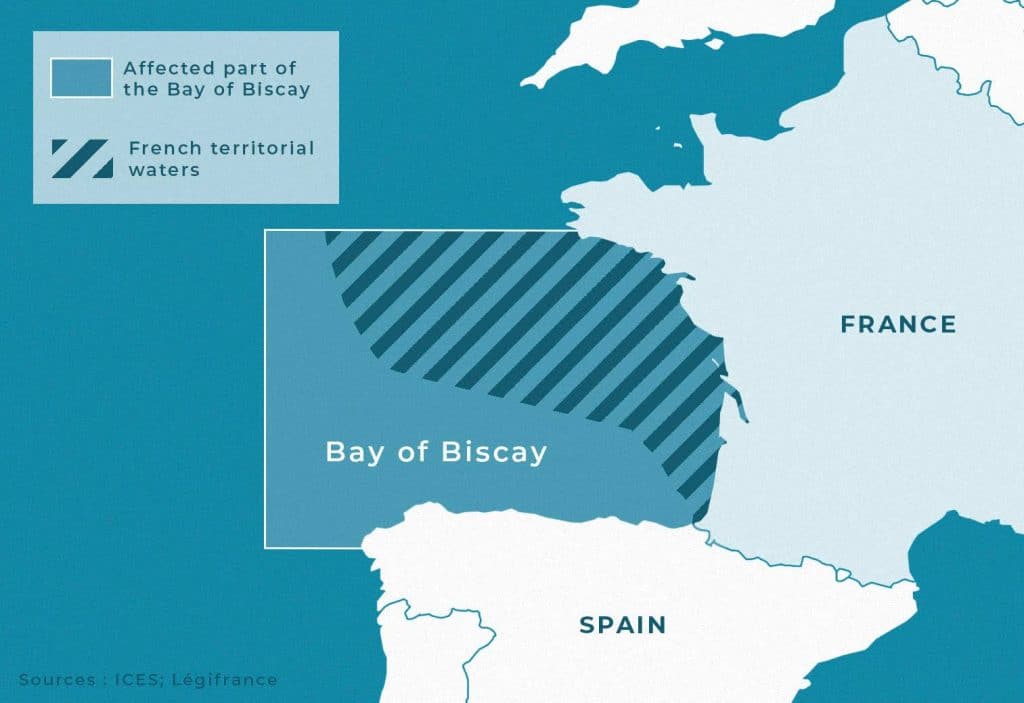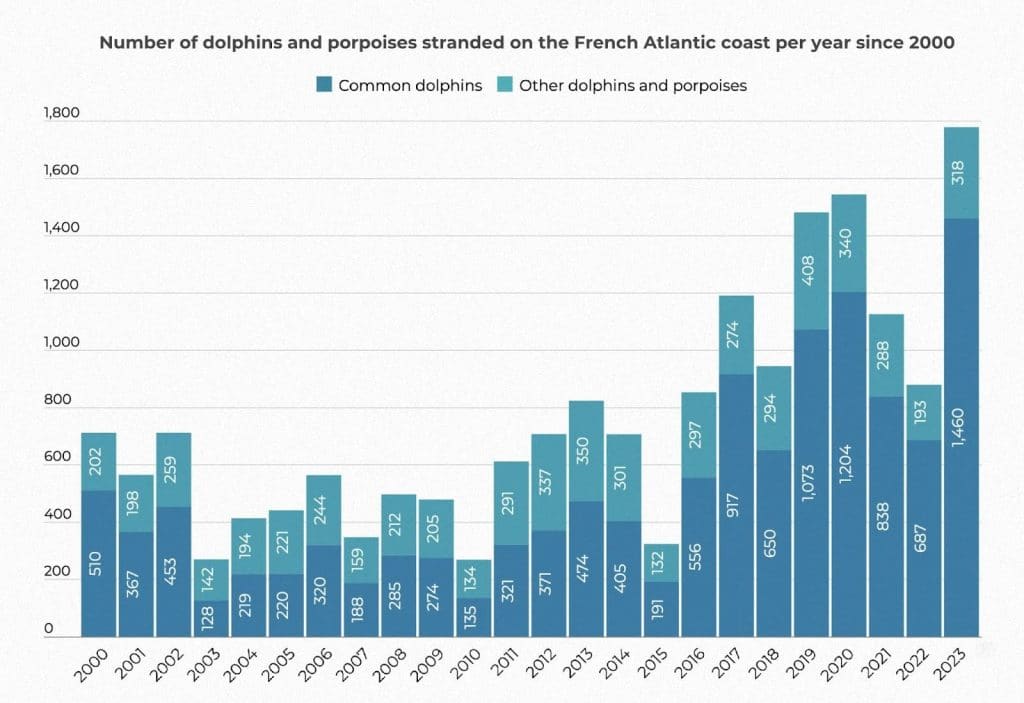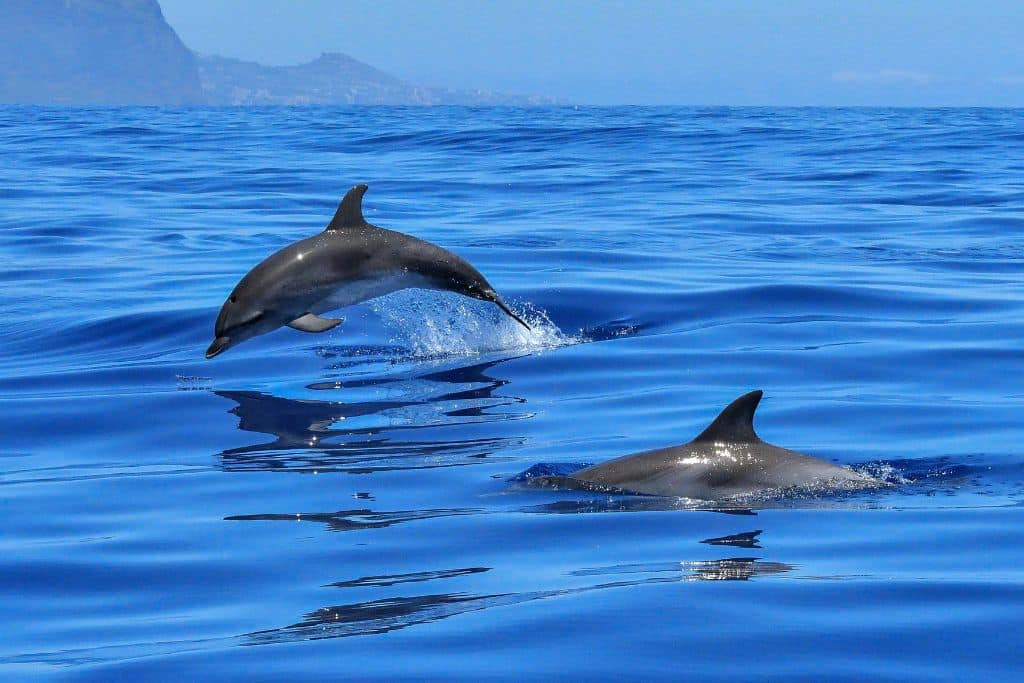In the Bay of Biscay, which lies along the French Atlantic coast, thousands of dolphins and porpoises die every year, trapped in fishing nets. In January 2024, France introduced a one-month ban on nearly all commercial fishing in the area to protect dolphins against the risk of regional extinction.
—
Referred to by three environmental NGOs in March 2023, the Council of State, the highest jurisdiction in France, ordered the government to close certain fishing areas within six months to protect dolphins and porpoises, thousands of which die every year from bycatch, the accidental capture of non-targeted animals during fishing activities.
In response, the State Secretary for the Sea Hervé Berville in October published a draft decree introducing a one-month ban on fishing for each of the next three years, starting in 2024. However, the decree was filled with exemptions, and only applied to certain types of nets and vessels. In December, the Council of State judged that these exemptions prevented the ban from having any significant chance of reducing the mortality of small cetaceans to a sustainable level.
The Council maintained the implementation of a four-week ban, which started on January 22 and lasted until February 20, 2023. However, the numerous initial exemptions were suspended. The ban still applied to purse seines, a method involving deploying a large wall of nets around schools of fish, which was initially excluded despite being responsible for 20% of accidental captures of dolphins in the area between 2019 and 2021.
The Council of State also revoked the exceptions that were planned for ships equipped with on-board cameras or acoustic deterrent devices – which are already mandatory for most at-risk vessels since 2020. According to the Council, these devices must be combined with a closed fishing period and cannot replace it.
Only ships of less than eight meters were still allowed to fish in the area during the ban. An exemption also remained for vessels using Danish seines, although this method – also known as “Scottish seine” or “fly dragging” – is highly controversial and accused of destroying the seabed, fish populations, and artisanal fishing communities.As a result of the ban, hundreds of fishing vessels had to stay at the dock for a month, including about 450 French ships as well as foreign vessels navigating in French waters. Had the decree been applied from the Secretary of the Sea with its many exemptions, only a dozen ships would have been affected by the ban.

Bycatch: The First Threat to Dolphin Populations in the Bay of Biscay
The four-week ban offered some respite to the marine mammals of the Bay of Biscay, in a period that is usually the most deadly for dolphins. During the winter months, plankton in the sea multiply, attracting sardines and anchovies. Dolphins as well as predators like bass, hake, and cod are fond of these little fish. And humans are fond of the latter. Dolphins hunt in the same waters as fishing vessels, and often end up trapped in nets they cannot see. Unable to free themselves, a lot of them suffocate and drown.
This is the fate of nearly 90% of all dolphins found stranded every year on the Atlantic coast. Their washed-up bodies bear the obvious marks of their accidental capture in giant nylon nets. More rarely, beached dolphins are found mutilated. According to Lamya Essemlali, President of Sea Shepherd France, this happens either because their meat has been consumed or because someone attempted to sink them to hide evidence of capture.
Among the fishing techniques used in the area, some are particularly risky for cetaceans: bottom trawls (large nets pulled by a boat which scrape on the ocean floor), midwater trawls (large net towed by one or two boats which moves between the surface and the seabed), bottom-set gillnets (nets vertically suspended in the water, anchored to the seabed), and trammel-nets (similar to a gillnet but with three layers of netting).
Bycatch is one of the primary causes of mortality of short-beaked common dolphins (Delphinus delphis) in the Bay of Biscay. Other animals are affected, too, like harbour porpoises (Phocoena phocoena) and Atlantic bottlenose dolphins (Tursiops truncatus).
Hundreds of cetaceans are found dead along the French coasts every year, including a large majority of common dolphins. But this already worrying figure only partially reflects the number of marine mammals killed from bycatch. Scientists from France’s PELAGIS Observatory for marine megafauna conservation estimate that between 5,000 and 10,000 dolphins die every year, with their carcasses sinking deep in the ocean without ever reaching the shore.

The situation has become so critical that small cetaceans are at risk of regional extinction. In 2019, the excess mortality rate of common dolphins due to accidental captures in the area was 1.49%, according to data from the French National Biodiversity Observatory. Although this figure may seem low, an excess mortality rate of 0.78% is enough to threaten the survival of this species.
Dolphins can live up to 40 years, but only mate between eight and 15 years old. They have one calf at a time, after a long 10-month gestation. This low reproduction rate makes them extremely vulnerable. At the current pace, the population of common dolphins in the Northeast Atlantic Ocean could become extinct within 40 to 50 years, even though the species is protected under the European Union Habitats Directive.
A Ban Contested by the Fishing Industry
While the newly adopted ban aims to protect dolphins, it leaves fishermen in an uncertain situation, with a significant portion of them suddenly prohibited from working. The ban was officially adopted less than a month before it began, leaving the fishing sector little time to prepare.
On January 19, Minister of Ecological Transition Christophe Béchu announced that vessels affected by the ban would receive financial aid amounting to 80-85% of their normal revenue, and that fishmongers would get support covering up to 75% of their losses. These benefits should be disbursed by early March, provided that the government receives approval from the European Commission. However, the ban has now come to an end and fishers have still not been able to apply for compensation.
Despite the promise of financial aid, fishermen and workers employed in the fishing industry have widely contested the ban. On January 31, 2024, around 20 fishermen gathered in Nantes in front of the Interregional Sea Directorate, dumping frozen fish and fishing nets on the building to express their frustration against a form of “regulatory pressure.”
“We are being suffocated. We identify with the farmers’ struggle. The pressure from French and European regulations is unbearable,” said David Le Quintrec, a fisherman from Lorient.
As a matter of fact, the fishermen’s outrage adds to an already tense context with farmers taking to the streets in France and across Europe in recent weeks. In the same way that many farmers protest environmental regulations, fishermen feel like the ban in the Bay of Biscay is “the last straw” that comes on top of rising operating costs and tightening national and EU standards, such as the reduction of fishing quotas voted in Brussels last December.
More on the topic: Explainer: Why Are European Farmers Protesting the EU’s Green Rules?
The French National Fisheries Committee’s (CNPMEM) president Olivier Le Nézet has even denounced “extremist” NGOs, accusing them of wanting to “wipe out our jobs and our trade by making the Bay of Biscay, where we have worked for centuries, a no-fishing zone.” He also asserted that common dolphins are “not endangered” in the area.
However, even if the ban is prompted by the need to protect cetaceans, it will also benefit fishermen in the long run. The root problem facing the sector is that fish populations have collapsed, making fishing harder and more expensive. This ban will give the fish time to grow and reproduce.
“Populations of commercial fish in poor condition, such as sole, whiting, blue whiting and Atlantic mackerel, will find some relief”, explained Jérôme Graefe, a legal expert at France Nature Environnement. Ultimately, this will have a positive influence on the entire industry.
A Long Way to Go for the Protection of Dolphins
Fishermen believe they are already doing enough to protect dolphins, by equipping their ships with cameras and acoustic deterrent devices, and feel misled by the Council of State’s decision to revoke the exemption for vessels equipped with this technology.
“The fishermen have shown great willingness by putting in the effort to be ready to sail in the required conditions”, said José Jouneau, Chairman of the Pays de la Loire Regional Fisheries Committee. “Today, 95% of them are equipped. Those who aren’t yet are waiting for the equipment to become available,” he added.
While these efforts must be acknowledged as they are essential both to keep dolphins away from fishing fleets and to document bycatch – which most fishermen still do not declare – such technological innovations are, as it is in many instances, insufficient to produce significant sustainable transformations. In fact, the massive deployment of acoustic repellents could have detrimental effects. By excluding dolphins from their feeding grounds in vast areas, there is a risk that they will no longer be able to meet their vital food requirements.
Besides, NGOs and scientists argue that, while a one-month ban is a historical first step, it is still far from enough to protect dolphins. The International Council for the Exploration of the Sea (ICES) assessed the efficacy of 15 different mitigation scenarios for protecting common dolphins in the Bay of Biscay. It concluded that the minimal requirement for ensuring the long-term viability of dolphin populations is a four-month closure of all commercial fishing in the Bay of Biscay, ideally three months in winter and one month in summer every year. Anything below that, including the current one-month ban, is not enough to sufficiently reduce dolphin deaths.
While it is still too soon to assess the success of this ban, the number of common dolphins found washed up on the shore are already showing promising results. To date, only 77 strandings have been recorded on the French Atlantic coast since January 2024, as opposed to 344 in January and February 2023. Further studies will be required to complete this data and estimate the effectiveness of the ban in protecting dolphin populations over the long term.
What’s the Best Approach?
There is no quick fix to the bycatch issue in the Bay of Biscay. Long-term, structural transformations require “contesting dominant social and political structures, and to reconsider the macro-economic dynamics of food production, as well as the deep cultural patterns interrelated with these dynamics,” according to researchers from La Rochelle University.
But protecting marine animals cannot be achieved without fishers. The lack of consideration of fishers’ needs and voice can reinforce conflict and undermine the success of mitigating initiatives. Instead, policies could be designed to empower fishermen, by encouraging experimentation of gentler fishing methods with a lower impact on ecosystems, for instance through economic incentives. Fishers can also provide valuable knowledge to help scientists and policymakers understand and prevent bycatch.
Individual consumption also needs to be questioned. One of the main reasons dolphins get caught in nets in the first place is because people want to keep eating large amounts of fish. The perverse effect of the implementation of bans on commercial fishing is that consumers might turn to imported fish, contributing to overfishing and potentially bycatch in other parts of the world. Reducing fish consumption, at least during certain periods of the year, might be part of the solution.
It would be an illusion to believe that dolphins can be protected while continuing to deploy giant nets throughout the Bay of Biscay. Questioning fish consumption, fishing methods and more largely the interrelations between society and marine ecosystems are essential steps towards transforming the fishing sector and protecting small cetaceans and fish populations alike.
You might also like: 7 Solutions to Overfishing We Need Right Now


















